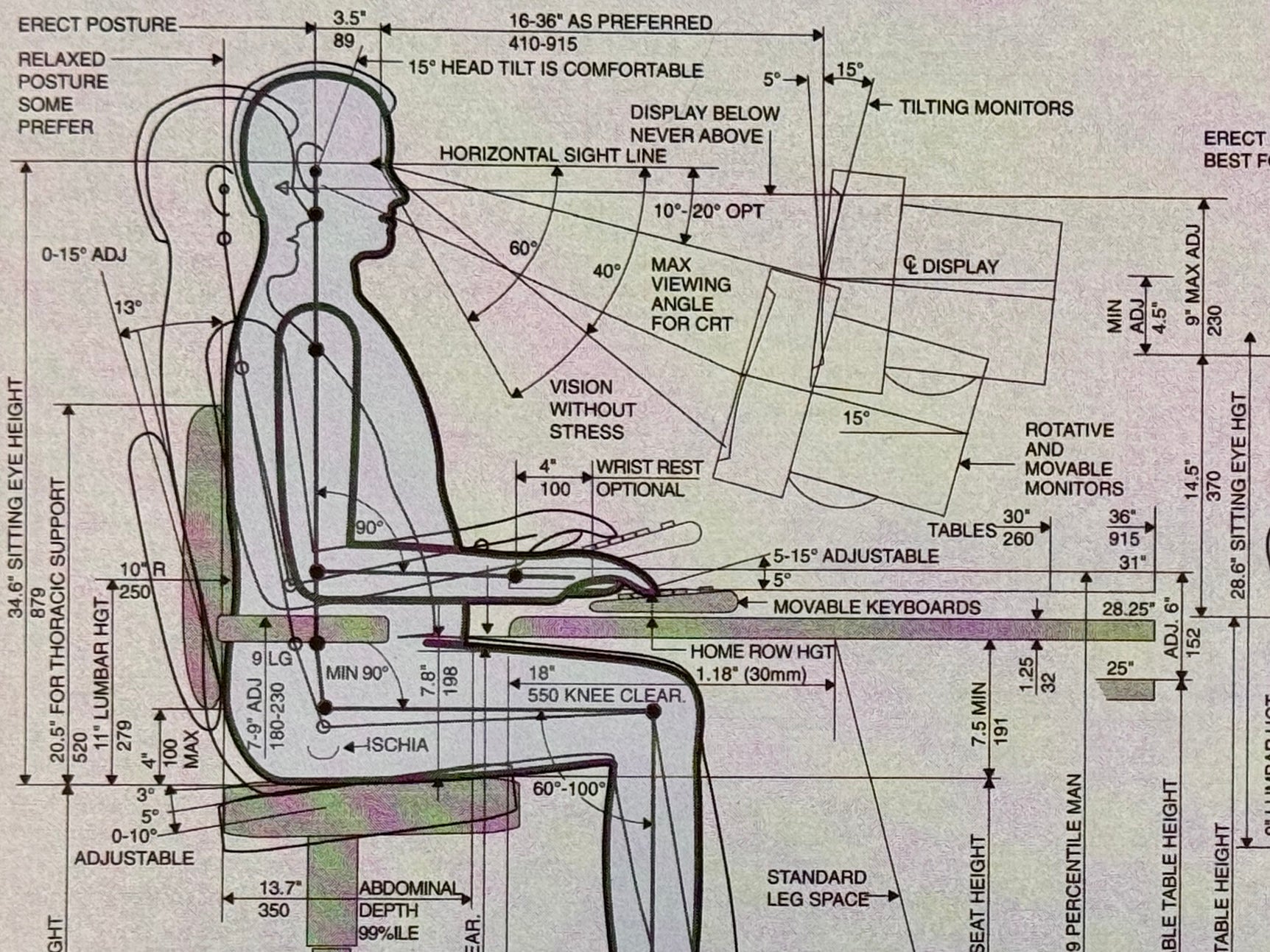Most of us intrinsically understand the importance of dedicated items for dedicated pursuits. Even in the age of multitasking, we still tailor the different items in our workspaces to be useful for what we want to accomplish. If you’re trying to cut some plywood but instead of using a table saw, you zip tie a Dremel to a TV tray, you’re going to have issues, yet this is what many of us have done with our production setups, and spent money in the process in creating the kluge.
Optimizing our workstation allows us to focus better on the task at hand, assuming it’s organized for that task, and things are properly set up ergonomically for that task.
Last week we dove into the height of Platform, this week we’re going to dive into the depth–how and why we chose how deep each tier is, as well as the ergonomic and gear justifications.
Once again, we consulted our measure of a human source of truth, ‘The Measure of a Man & Woman, Human Factors in Design’ by the Henry Dreyfuss Associates. In case you missed last week, this book is an encyclopedia of human sizes and averages of everything from how much room an average man takes up lying prone, to the average angle of bifocals when sitting for best display height. Below are two pages we used while deciding heights, and a third page that helped with depths.



Beyond just designing for how far people can reach (pun intended), when you’re designing a studio desk, you have some added complexities. With the keyboard tray, we knew we were going to be dealing with 3 tiers. That is, the keyboard tier, the main desktop, and the bridge which rack gear could mount under. We also needed to assume different workflows for different configurations, as in, what people would be doing with the keyboard tray pulled out vs. pushed in.
Our assumption, which was confirmed by design studies, is that folks would compose with the tray out, but mix with the tray in. We expect that some people will have their near field monitors on the bridge, so we needed to create an equilateral triangle between their head and the two monitors with the keyboard tray pushed in. Working from there (with width set at 60” due to rack spaces), and assuming knee cutout, we put the front of the desktop 18” from the bridge (not counting the angle of the dividers), and on the updated Platform where the tray sticks out 4” (we’ll get to that), the front of worksurface (front of keyboard tray) 22” from the bridge. Assuming knee cutout, this puts an averaged sized person around 36” from the center of the bridge. This creates a nearly perfect 40” equilateral triangle between two tweeters and head in the mix position. If you use stands, this also allows you to just move them back slightly and get a bigger triangle.

In addition to acoustics, we wanted a useful main desktop size, fortunately that fell into place with 15”-18” of depth (depending on divider orientation), which accommodates nearly all reasonably sized control surfaces, drum machines, desktop synths, and a qwerty/mouse. Ergonomically this depth also puts you at a good distance to still be able to reach all the controls on racked gear while mixing without having to really strain. While some shorter folks may have to reach for outer racked gear, most people can reach the front of the middle rack space while keeping their heads in the sweet spot (back to acoustics).
As far as how far we extended the desktop away from the user under the bridge (sometimes I feel like I don’t have a partner… sorry), we actually shortened that dimension with the updated Platform. On the original Platform, the desktop extended all the way back behind the desk, where we hung cable management from. We found through feedback and our own experience that all that did was make it hard for any racked gear to breathe, and also really hard to access the cable deck from the front of the desk for mostly unused space. People were using the front half of the desktop under the bridge, but the back half mostly just had cables, or nothing sitting on it, collecting dust. With that realization, we shortened it, but still left real estate for hard drives and most gear people were using. This also allowed us to tuck a MUCH larger cable deck in between the legs and below the shortened desktop, giving access to the cable deck from the front of the desk if the space isn’t racked. Also, if your space is racked, your gear will breathe much better. Lastly, it makes assembly and handling MUCH easier.
I don’t mean to sound defensive here (even though I am), but I’ve seen chatter that this was a cost cutting move. This was absolutely a feature driven decision, and as a counterpoint, we use about the same amount of material when the larger cable deck is taken into account–this did not save us money on the cost of Platform. It also cleans up the profile of the desk (I was never a fan of the desktop sticking out the back of the first Platform). It’s better looking, and better functionally.
With the main desktop dimension set, we moved onto the keyboard tray. Another benefit to making the keyboard tray standard is that it allowed us to move it further forward on the assembly, which allows you to more easily play if it’s pushed in, something that people asked for. We went with nearly 15” for the depth of the tray, because it accommodates most drum machines, and nearly every keyboard controller made. It also is a good depth to not put you a mile from the display, or out of sweet spot and your qwerty, when it’s pulled out.
The bridge depth is pretty much a carryover from the first Platform. This depth is partly determined by the whole equilateral triangle with studio monitors requirement, but also is long enough to keep almost all rack gear covered (I say almost, but I actually can’t think of any gear that would stick out the back). This also keeps the cable management holes unencumbered by anything below, for a straight shot to the aforementioned cable deck.
I hope you’ve gathered that none of the dimensions of Platform were arbitrary. We put great thought into every dimension to both work with the measure of people, but also enhance our specific music production workflows.




